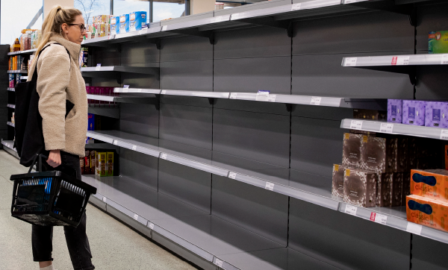Transparency Requires Collaboration: Key Takeaways from 2024 GS1 Connect: Thrive
Clarkston Consulting recently attended the 2024 GS1 Connect: Thrive Conference, joining industry peers and leaders from supply chain, technology, and data to discuss strategic insights and tactical solutions to “Unlock the Full Value of Your Supply Chain.” Below, Wesley Ange, Client Solutions Executive, shares his key takeaways from 2024 GS1 Connect: Thrive, emphasizing the importance of collaboration among companies to find the best solutions to enhance traceability and ensure data visibility.
Key Takeaways from 2024 GS1 Connect: Thrive
1. Everyone’s talking about FSMA 204.
With the traceability regulation only 19 months away, Food Safety and Modernization Act (FSMA) 204 regulation was a popular discussion for the Food and Drug Administration (FDA), food companies, and solution providers alike. There were eight sessions dedicated to the topic– not to mention a reference in every traceability solution provider’s booth. The importance of this topic was emphasized by the fact that the Drug Supply Chain Security Act (DSCSA) was only covered in three sessions for comparison.
Some companies are still planning their approach, having worked through initial planning and proof of concepts. Others are well down the path of engaging with members of the supply chain to share the required information. The approach to meeting FSMA 204 regulation requirements was as varied as the types of companies that spoke about it. Some companies are aiming to meet the requirement and capture enhanced traceability data for only the Food Traceability List (FTL) items; others plan to capture the required data elements for all items where an FTL item is processed; and a few companies are seizing the opportunity to overhaul their entire traceability programs. Regardless, if a company hasn’t yet decided on their approach, the first step would be to determine what is feasible and how it could scale.
2. Success requires collaboration.
If there was a second theme running through the conference, it was the importance of collaboration. That collaboration was seen in a variety of ways, whether it was speakers challenging companies to collaborate on ideas and share best practices between each other (if it isn’t a differentiator or proprietary), or companies themselves discussing ways to collaborate with standard companies like GS1 on what’s needed to drive business in the future.
Of course, there’s the emphasis on internal collaboration, too, with marketing, customer experience, supply chain, operations, and item management all working together to create clean data records and think jointly about how to create new customer experiences, enhance insights, improve sustainability, and more. Collaboration even included regulators, as clear regulations will create a field on which companies can operate.
For instance, if retailers want to ensure the story of responsibly raised salmon used for in-house sushi reaches the consumers in a way they’re prepared to consume, it will require collaboration across all of the groups listed above. This is one simple example that includes effort and input from multiple departments. Setting up a cross-functional team is the first step that all companies should be taking to ensure this success.
3. Consumers are evolving – and so are their expectations.
What does the typical consumer look like in 2024? That may depend on the individual and their location – U.S., Europe, China, etc. While each consumer today is different, they do share some common traits. They survived the pandemic, splurged coming out of it, and now – with stocked up money spent and rising inflation – are continuing to watch price points, which was a normal behavior for a pre-pandemic consumer but now comes with different expectations.
Consumers’ expectations of speed and transparency are dramatically different than pre-pandemic: online deliveries appearing within hours (and certainly by the following day); ordering online and picking up in store; or shopping in the store and having an unavailable item shipped directly to their home. Additionally, consumers want to know more information about their purchase – where it came from, what materials were used, how to care for it, and maybe even how to resell it – and they’re looking for this information when moving through the standard buying process.
To meet this expectation for both convenience and transparency, we’re seeing more companies include 2D barcodes or QR codes that provide full stories about the product. A few have begun to create digital product twins that tell the unique story of the product and allow for it to be tracked through its entire lifecycle. Adoptions of these labels are also linked to upcoming regulation and industry commitments, like Sunshine 2027 and the Ecodesign for Sustainable Products Regulation (ESPR) in the EU, so companies are now looking to meet both consumer and industry requirements.
Companies are on a journey to meet these new expectations. The resounding advice from the conference was to get started even if on a single product or line because then you can learn and improve.
4. It’s all about the data.
Data was discussed nearly non-stop at the GS1 2024. The topics ranged from the importance of data quality for internal operations, customers trusting the data they’re consuming, and avoiding bias when training Artificial Intelligence (AI). A commonly referenced quote during the conference was, “If data is the oil a company is running on, the ducts are broken.” This means that companies must be committed to establishing good data management practices for master data records and the validation needed for transactional records. A poll taken during one of the discussions showed that inaccurate traceability data was the biggest fear related to the increased traceability information required by regulation and consumers. This means that ultimately, companies must commit to the “less sexy” work of increasing data quality and then they can begin the work on increasing consumer trust and using data tools to gather insights.
Looking Ahead
There was so much covered at the conference that it’s impossible to cover it all in just these key points above. We also heard discussions around the use of RFIDs, incorporating robots into warehouses, looping humans into AI practices, and more. What’s clear across all the topics, however, is how critical it is to understand the problem before chasing the technology, to do the upfront work to ensure quality data, and to collaborate, collaborate, collaborate.
Whether it’s creating a strategy to increase the quality of your data or to achieve FSMA 204 compliance – or even to ensure collaboration across teams – Clarkston Consulting has helped other companies in these areas and would be thrilled to partner with you. Let us know your thoughts on our key takeaways from 2024 GS1 Connect: Thrive, and reach out to us today.
Subscribe to Clarkston's Insights



